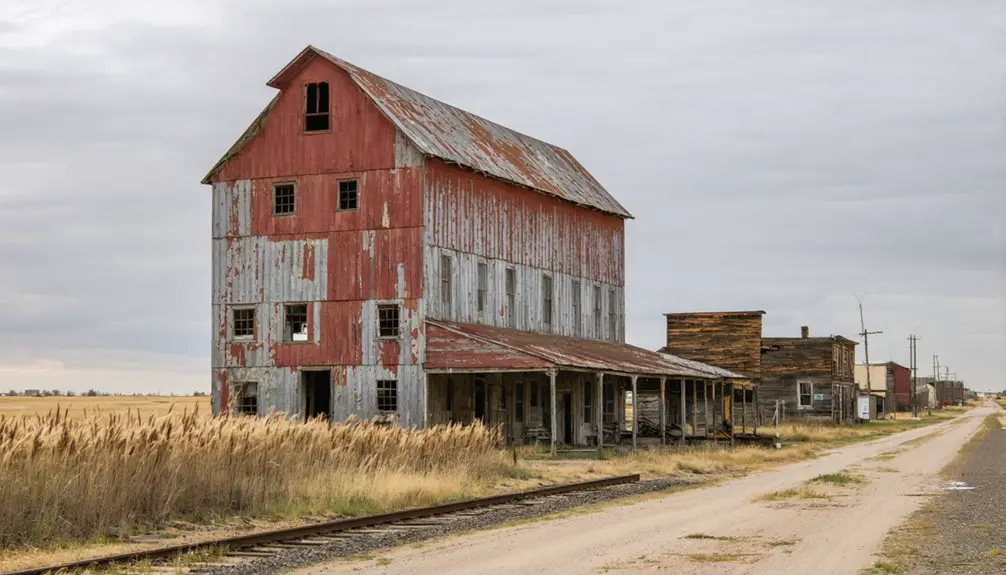You’ll find Vicksburg’s haunting remains along the Minnesota River in Renville County, where it thrived from 1867 until 1905. Named to honor a significant Civil War victory, this frontier settlement bustled with agriculture and trade until major railroad companies bypassed it, sealing its fate. Today, you can explore Vicksburg County Park and its historic cemetery, where paranormal activity and mysterious glowing tombstones hint at stories that live on after the town’s death.
Key Takeaways
- Vicksburg was established in 1867 along Minnesota River but became a ghost town by 1905 after being bypassed by major railroads.
- The town’s decline was primarily caused by railroad companies redirecting routes elsewhere, severing vital economic and transportation lifelines.
- Only the historic Vicksburg Cemetery remains, featuring eight documented memorials and reported paranormal activities including glowing tombstones.
- During its peak, Vicksburg served as an agricultural hub, producing 2,732 bushels of wheat by 1880.
- Vicksburg County Park now preserves the ghost town’s location, offering camping, hiking trails, and access to Minnesota River.
The Rise of a Minnesota River Settlement
As settlers pushed westward following the Civil War, the town of Vicksburg emerged along the Minnesota River in Flora Township, Renville County.
You’ll find its origins tied to the 1867 platting, when the town was named to commemorate the historic Civil War surrender of Vicksburg, Mississippi.
The settlement’s strategic location near the riverbank made it ideal for river transportation and early agriculture. Like many settlements along major waterways, Native American tribes including the Sioux and Ojibwa had long utilized these fertile riverbanks before European settlement.
You can imagine the bustling scene as the town quickly established essential services: a post office in 1871, general store, sawmill, and blacksmith shop.
Similar to Vicksburg, Mississippi’s growth from 4,000 cotton bales in 1825, the Minnesota settlement saw steady increases in agricultural production.
The creamery and sorghum press showcased the community’s agricultural focus, while the doctor’s office, church, school, and saloon created a self-sufficient hub.
The fertile lands and river bluffs provided natural resources that supported the town’s initial growth and development.
From Civil War Victory to Town Name
The town’s name carries a profound historical weight, rooted in one of the Civil War’s most significant victories.
The legacy of a crucial Civil War battle echoes through time in this town’s carefully chosen name.
You’ll find Minnesota’s connection to Vicksburg runs deep, as the state’s Fourth Minnesota Volunteer Infantry played a vital role in the Mississippi campaign, even capturing an entire Alabama regiment during the fighting.
John B. Sanborn’s leadership was instrumental in securing Union control of the Western Theater.
When citizens chose to name their settlement Vicksburg, they weren’t just picking a random Civil War reference. The victory at Vicksburg led to Union control Mississippi, cutting off vital Confederate supply lines and communication routes.
The town naming honored both the pivotal Union triumph that split the Confederacy and Minnesota’s own soldiers who helped secure that victory.
This deliberate choice reflected the immense pride Minnesotans felt in their contributions to what President Lincoln called the “key” to ending the war, forever linking their local identity to this watershed moment in American history.
Life in Early Vicksburg
In early Vicksburg, you’d find settlers working the dark loam soil and harvesting hay from the river bottoms, while others managed timber operations in the surrounding forests.
You’d see the town emerge as a modest trading hub where farmers and merchants could exchange goods near the convergence of the Elk, St. Francis, and Rum rivers.
The community’s social fabric centered around agricultural activities and basic frontier institutions, with Civil War veterans like James Okins helping to establish the town’s earliest gatherings. Minnesota’s strong Union commitment was evident in the town’s patriotic celebrations and veteran gatherings. Farmers produced substantial yields for the era, including 2,732 bushels of wheat according to the 1880 census.
Daily Pioneer Activities
Life in early Vicksburg centered around intensive manual labor, with pioneer families dedicating their days to essential agricultural and household tasks.
You’d find settlers working their modest 367 acres of dark loam soil, cutting timber from abundant forests, and tending to livestock along the river bottoms.
Your daily routines would’ve included gathering wood for heating and construction, maintaining farm equipment, and preserving food through salting and smoking.
Agricultural techniques focused on hay production in the meadows, while you’d rely on the Elk, St. Francis, and Rum rivers for irrigation.
You’d work alongside neighbors, sharing tools and labor to clear land and build structures.
When you weren’t farming, you’d participate in community gatherings and postal services, maintaining crucial connections despite the frontier’s isolation.
Residents could visit the general store to purchase supplies and exchange news about the community.
The town’s steady decline began when it was bypassed by railroads, leading families to gradually relocate to better-connected communities.
Commerce and Trade Hub
While railroad expansion transformed Minnesota’s commercial landscape, Vicksburg initially thrived as a modest trade hub along the Minnesota River until 1905.
You’d find the heart of local trade centered around essential businesses that served both townspeople and surrounding farms. The general store provided daily necessities, while the creamery and sorghum press supported agricultural commerce by processing dairy and sweet sorghum crops.
At the town’s peak, you could’ve visited the sawmill for lumber, stopped by the blacksmith for tool repairs, or conducted business at the post office. The saloon served as an informal meeting spot where merchants and farmers struck deals. A hand-powered ferry service provided vital river crossings for just 5 cents per day. Like many entries in place name disambiguation, Vicksburg’s identity became intertwined with other similarly named locations across America.
However, when major rail lines bypassed Vicksburg, you’d have witnessed its gradual decline as neighboring rail-connected towns drew away commerce and trade opportunities.
Community Social Gatherings
Early Vicksburg residents came together through a vibrant network of social gathering spots that shaped daily life from 1871 to 1905.
You’d find townsfolk congregating at the general store, sharing news while picking up supplies, or meeting at the saloon for casual conversation after a long day’s work. The church stood as a cornerstone of community life, hosting regular church events that strengthened neighborly bonds through worship and celebration.
Social dances brought young and old together in communal spaces, while seasonal festivities marked important agricultural milestones.
You might’ve joined your neighbors at the sorghum press or creamery, where work and socializing blended naturally. The schoolhouse buzzed with activity beyond lessons, hosting plays and fairs that drew families together and preserved the town’s shared identity.
The Fatal Impact of Railroad Decisions

You’ll find a crucial moment in Vicksburg’s history around 1905, when major railroad routes bypassed the once-promising Minnesota town in favor of neighboring communities.
While Vicksburg initially benefited from the Peninsular Railroad’s east-west line in 1872, the town’s fate was sealed when competing railroads redirected their main routes elsewhere, effectively cutting off essential transportation access.
The loss of rail connectivity proved catastrophic, as it isolated the community from commercial opportunities and trade networks, setting in motion an irreversible decline that would transform Vicksburg into a ghost town.
Rail Routes Seal Fate
Despite Vicksburg’s promising start in 1867, the town’s ultimate downfall came from crucial railroad routing decisions in the late 19th century.
You’ll find that railroad companies systematically bypassed this small Minnesota settlement, choosing instead to lay tracks through larger population centers with more strategic advantages. The economic impact was devastating – without rail connections to transport agricultural goods and connect to regional markets, you couldn’t sustain local commerce or attract new residents.
While other Minnesota towns flourished with the arrival of multiple rail lines, Vicksburg’s isolation sealed its fate.
You’d have watched as the town’s infrastructure crumbled – the general store, creamery, sawmill, church, and school all succumbed to the exodus of residents.
Transportation Access Disappears
Transportation access to Vicksburg suffered a fatal blow when major railroad companies systematically redirected their routes away from the town in the late 19th century.
The transportation decline created a devastating ripple effect, cutting off essential economic lifelines that had sustained local businesses and industries.
- You’d have witnessed the town’s economic isolation intensify as the loss of rail service severely limited access to regional markets and trade routes.
- You’d have seen the devastating impact on local enterprises – from the creamery to the sawmill – as they struggled without reliable freight service.
- You’d have noticed how the lack of passenger rail deterred new settlers while driving existing residents to seek opportunities elsewhere.
What Remains Today: Cemetery and Park
The historic Vicksburg Cemetery stands as the primary remnant of this forgotten Minnesota town, situated north of the original townsite at coordinates 44.66389°N 95.22694°W in Renville County.
Cemetery preservation efforts maintain the site’s accessibility, featuring at least eight documented memorials with headstones dating back to the late 19th century.
You’ll find the cemetery near Vicksburg County Park, formerly known as County Park 2, which offers several park amenities including primitive campsites, picnic grounds, and restrooms.
The park provides hiking trails and boating access to the Minnesota River.
While ghost hunters frequently visit the cemetery due to reported paranormal activity, both the cemetery and park serve as peaceful destinations where you can explore local history amid natural prairie and woodland settings typical of the region.
Tales From Beyond the Graves

Since its abandonment in 1905, Vicksburg Cemetery has earned a reputation as one of Minnesota’s most haunted locations, drawing paranormal enthusiasts and ghost hunters from across the region.
If you’re brave enough to venture down the wooded path to this secluded clearing, you might experience the ghostly encounters that have made this site infamous.
- A mysterious glowing tombstone reportedly bleeds flowers each spring.
- Visitors report cemetery whispers, unexplained screams, and physical sensations like pinching.
- Photographers have captured inexplicable orbs and light anomalies throughout the grounds.
You’ll find yourself surrounded by tragic tales of those laid to rest here, including young children whose spirits are said to linger.
Many visitors report feeling watched or followed, while others claim to witness spectral figures walking the old townsite paths at twilight.
Nature and Recreation at the Old Townsite
Nestled along the Minnesota River corridor, Vicksburg County Park offers visitors a blend of natural wonders and outdoor recreation opportunities at the site of the former ghost town.
You’ll find primitive campsites perfect for an authentic outdoor experience, along with picnic areas and restrooms to support your stay.
For nature exploration, you can traverse wooded hiking trails that lead to scenic river vistas and the historic Vicksburg Cemetery.
The park’s diverse habitat supports abundant wildlife, making it ideal for birdwatching and wildlife observation.
If you’re drawn to water-based recreational activities, you’ll have direct access to the Minnesota River for canoeing and kayaking adventures.
Just remember to wear sturdy footwear – the terrain can be challenging, especially along the heavily wooded paths.
Legacy of a Lost Frontier Community

While today’s visitors explore Vicksburg’s natural landscapes, a rich historical legacy lies beneath their feet. From its establishment in 1867 to its abandonment in 1905, this frontier town showcases the cultural significance of Minnesota’s pioneer settlements and their vulnerability to changing transportation networks.
- You’ll discover how the town’s name commemorates the Civil War surrender of Vicksburg, Mississippi, connecting this settlement to broader national history.
- You’ll find evidence of a once-thriving community through historical preservation efforts at the cemetery.
- You’ll encounter a reflection of frontier life through the town’s remaining stories of general stores, blacksmith shops, and community gathering places.
The ghost town’s legacy endures as a powerful reminder of how railroad decisions shaped the destiny of frontier communities.
Frequently Asked Questions
Are There Any Surviving Photographs of Vicksburg During Its Active Years?
Like footprints in shifting sand, Vicksburg photographs from its heyday haven’t survived in any known archives. You won’t find images from when the town bustled with life during its active years.
What Happened to the Residents After They Left Vicksburg?
You’ll find that residents dispersed to nearby towns like Delhi, following the railroad’s path. The displacement effects split families across Minnesota, though their community legacy endures through cemetery visits and shared memories.
Did Any Notable Historical Figures Ever Visit or Live in Vicksburg?
You won’t find any historical visits or notable residents in the town’s records. Despite drawing hopeful settlers to its promising frontier location, no famous figures ever called Vicksburg home.
What Were the Property Values of Buildings When the Town Was Abandoned?
You won’t find exact property assessments from when the town was abandoned, as no records survive. The economic decline suggests buildings had minimal to zero market value by 1905.
Were There Any Documented Crimes or Major Accidents in Vicksburg’s History?
Perplexingly pristine records show you won’t find any documented crime incidents or accident reports from Vicksburg’s brief existence. The town’s peaceful decline was due to railroad bypassing, not tragic events.
References
- https://en.wikipedia.org/wiki/Vicksburg
- https://www.pinterest.com/pin/vicksburg-may-be-the-creepiest-abandoned-town-in-minnesota–155866837089588925/
- https://river967.com/dont-visit-this-southern-minnesota-haunted-cemetery-alone/
- https://www.minnesotahauntedhouses.com/real-haunt/vicksburg-cemetery.html
- https://thievesriver.com/blogs/articles/ghost-towns-in-minnesota
- https://www.battlefields.org/learn/articles/vicksburg-mississippi-founding-through-antebellum-era
- https://www.britannica.com/place/Mississippi-River/History-and-economy
- https://en.wikipedia.org/wiki/Mississippi_River
- https://www.battlefields.org/learn/civil-war/battles/vicksburg
- https://suvcw.org/sites/default/files/2023-04/MS_Warren_Co_Vicksburg_Minnesota_Monuments_redacted.pdf



